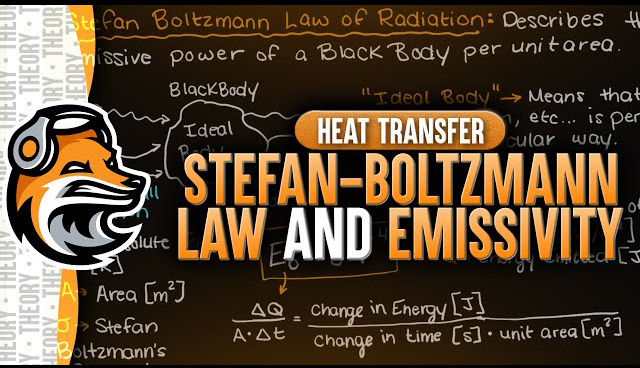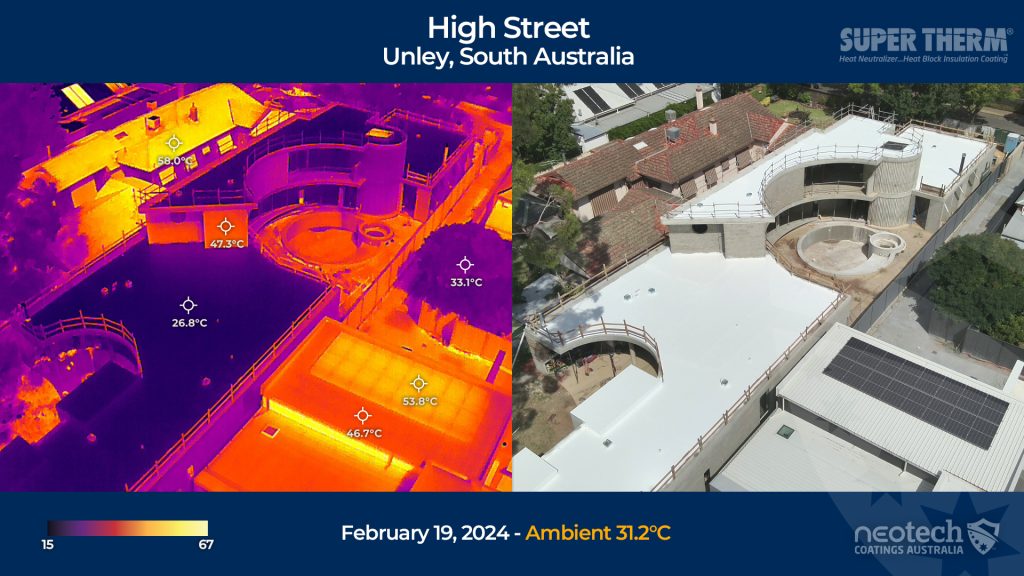Stefan-Boltzmann law, Ceramic Coatings and Emissivity
Super Therm® ceramics thermal insulation coatings surface can have low solar absorption and high emissivity
Low solar absorption means the surface absorbs a small fraction of the solar energy it’s exposed to, which helps keep it cooler under sunlight.
High emissivity refers to the surface’s ability to emit, or radiate, absorbed heat.

Materials designed with these properties are efficient for thermal management, reflecting and blocking most of the solar radiation while also effectively radiating away the heat they do absorb. This combination is beneficial in applications aiming to reduce heat gain and improve energy efficiency, such as in certain coatings and building materials.
Wikipedia article on emissivity that explains how emissivity and solar absorption are related. It details various materials and their emissivity values, indicating how these properties are fundamental in heat flow and thermal calculations across various industries, including aerospace and electrical work.
Other coatings companies (independent of NEOtech) also provides an in-depth look at coatings that can adjust the ratio of absorption to emissivity. They discuss how their silicon-based coatings can significantly impact the emissivity of materials, making them more efficient in emitting thermal radiation while reducing solar absorption. This is particularly useful in applications where managing heat flow is critical, such as in aerospace components exposed to direct sunlight.
Stefan–Boltzmann law simply explained
Imagine you’re holding a really bright torch or flashlight that shines super bright light. The Stefan-Boltzmann law is like saying the brighter your torch or flashlight shines, the more light it sends out into the room. If your torch or flashlight is really, really hot, it shines way brighter and fills the room with lots of light.
Now, think about wearing a dark shirt on a sunny day and how it gets really hot, while a white shirt stays cooler. That’s kind of like emissivity. Emissivity is how good something is at being like the dark shirt that gets hot in the sun and then cools down by letting out heat. Some things are really good at it, like the dark shirt, and they let out a lot of heat. Other things aren’t so good at it and don’t let out much heat. However it is noted that black absorbs the full spectrum of solar heat therefore making it hotter than the white. Don’t be misled between reflectivity of light bounce and heat absorption.
So, the Stefan-Boltzmann law is about how much light (or heat) something can send out when it’s hot, and emissivity is about how good something is at letting out that heat.
The complicated version of Stefan–Boltzmann law
The Stefan-Boltzmann law is a principle in physics that defines the total energy radiated per unit surface area of a black body across all wavelengths per unit time. It states that the total radiant heat energy emitted from a surface is directly proportional to the fourth power of its absolute temperature. The law can be mathematically expressed as E=σT4, where E is the emissive power (energy per unit area per unit time), σ is the Stefan-Boltzmann constant (5.67×10−8 W m−2K−45.67×10−8W m−2K−4), and T is the absolute temperature in Kelvin.
Emissivity (ϵ) is a measure of a material’s ability to emit thermal radiation compared to that of an ideal black body, which is perfect at emitting thermal radiation. Emissivity is a dimensionless quantity ranging from 0 to 1, where 1 indicates perfect emission (a black body), and 0 indicates no thermal radiation emission. The concept of emissivity is critical in real-world applications because it modifies the Stefan-Boltzmann law to account for the fact that most materials are not perfect black bodies. Thus, the modified law for real surfaces becomes 4E=ϵσT4, allowing us to calculate the thermal radiation from surfaces with various emissivities.
In practical terms, emissivity affects how hot or cold a material appears to thermal imaging cameras and influences the thermal management of materials in various engineering and scientific applications, from the design of buildings and vehicles to the study of planetary atmospheres.
When is Stefan–Boltzmann law not applied to emissivity and solar absorption?
The Stefan-Boltzmann law, which relates the total energy radiated per unit surface area of a black body to the fourth power of its temperature, assumes that the body is an ideal emitter across all wavelengths. However, there are scenarios where the Stefan-Boltzmann law does not directly apply to emissivity and solar absorption calculations:
- Non-Black Bodies: For real materials that are not perfect black bodies (which have an emissivity (ϵ) of 1), the Stefan-Boltzmann law is modified by the emissivity factor. Emissivity values range from 0 to 1, and for such materials, the total radiated energy is less than a perfect black body. However, if the emissivity varies significantly with temperature or wavelength, the simple form of the law may not accurately predict thermal radiation.
- Wavelength-Dependent Emissivity: When emissivity varies across different wavelengths, the Stefan-Boltzmann law’s assumption of constant emissivity is invalid. This is particularly relevant for materials that absorb and emit radiation differently at various wavelengths, such as solar absorbing materials that have low emissivity in the visible spectrum but high emissivity in the infrared spectrum.
- Transparent or Translucent Materials: The law applies to surfaces that are opaque to thermal radiation. For materials that are partially transparent or translucent to infrared radiation, the law does not accurately describe the thermal radiation behavior, as transmission through the material must also be considered.
- Non-Equilibrium Conditions: The Stefan-Boltzmann law is derived under the assumption of thermal equilibrium. In non-equilibrium situations, such as when there are significant temperature gradients within the material or between the material and its environment, the law does not directly apply.
- Small Objects or Thin Films: At the microscopic scale, quantum effects and surface interactions can significantly influence emissivity and absorption. For very small objects or thin films, the assumptions underlying the Stefan-Boltzmann law may not hold, leading to deviations in expected thermal radiation behaviour.
- Atmospheric Effects: In outdoor applications, atmospheric absorption and re-radiation can affect the net radiation observed from a surface. The Stefan-Boltzmann law does not account for these effects, which can be significant for solar absorption and emissivity measurements in environmental contexts.
In these scenarios, more complex models and empirical data are often required to accurately predict the thermal radiation behaviour of materials, taking into account their specific physical properties and the environmental conditions.

Can ceramic coatings effect Stefan–Boltzmann law?
Ceramic coatings can’t directly affect the fundamental principles of the Stefan-Boltzmann law, which relates the amount of heat radiated from a black body in thermal equilibrium to the fourth power of its temperature. However ceramic coatings can significantly impact the effective emissivity of the surface they are applied to and significantly reduce the total solar absorption, which in turn influences the amount of thermal radiation emitted from that surface according to the Stefan-Boltzmann law.
The Stefan-Boltzmann law, in its practical application, is often modified to include the emissivity (ϵ) of a surface, making the emitted power equal to ϵσT4, where σ is the Stefan-Boltzmann constant and T is the absolute temperature. Ceramic coatings can have high or tailored emissivity properties, allowing surfaces coated with these materials to emit more thermal radiation than uncoated surfaces or those coated with materials of lower emissivity.
For instance, certain ceramic coatings are designed to have a high emissivity in the infrared spectrum, which means they can effectively radiate away heat. This property is particularly beneficial for thermal management applications, such as in building exteriors or in aerospace, where controlling temperature through radiative heat loss is important.
Moreover, ceramic coatings can also be engineered to have low solar absorption properties, reflecting more solar radiation and absorbing less, thereby reducing the heat gain from solar radiation. This aspect is especially useful for energy efficiency in buildings or vehicles.
In summary, while ceramic coatings do not alter the Stefan-Boltzmann law itself, their properties can significantly influence the effective emissivity of a surface. This, in turn, affects the thermal radiation emitted from the surface, making ceramic coatings a powerful tool for controlling heat transfer in many applications.









